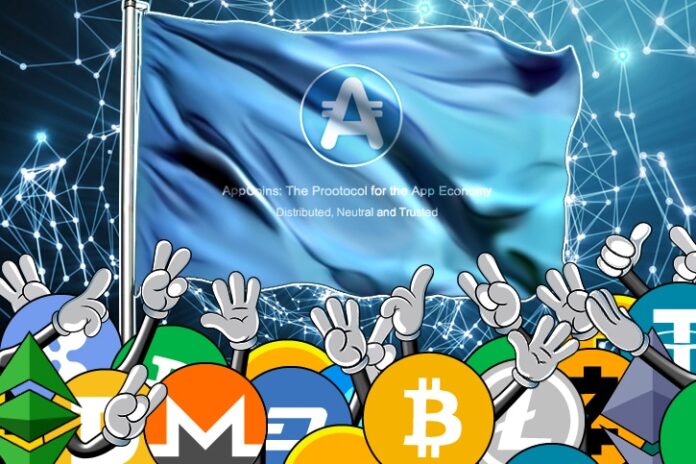The app economy is ripe for disruption
As consumer devices such as smartphones become cheaper to own, and with telecommunication networks spreading outside of urban concentrations, they are becoming more and more ubiquitous by the day. Along with that, a thriving application (app) economy has emerged as one of the serious players in the global tech economy.
About a quarter of the world’s population own and use a smartphone, together generating over $77 billion in annual gross revenue through app-related purchases. According to app analytics firm App Annie, the global app economy will be worth $6.3 trillion by 2021 with a user base of over 6 billion users, spending a collective 3.5 billion hours annually on app usage. These figures take into account not only revenue generated from app store purchases but other forms of monetization like in-app ads and mobile commerce.
Western markets will lag behind East Asia
Clearly, the numbers are indicative of widespread usage of apps, with more users willing to spend their money on buying new apps or making in-app purchases (IAP). However, digging deeper into these numbers, it is also evident that there are several factors affecting the growth of this market.
Japanese consumers currently lead the pack, spending an average of $13.98 per hour per user, clocking up 68 billion hours in 2016. US consumers paled in comparison, spending only $2.36 per hour.
This is put down to the slower shift of Western markets – or the rest of the world outside of Japan, for that matter – in moving from legacy systems to modern, mobile ones, as with banking and payment transfers, for example.
App stores hold the lion’s share of the app economy
The current giant in the app store business is the iOS Apple Store, expected to rake in $60 billion by 2021. However, Google Play, combined with other third-party Android app stores based out of China, are predicted to overtake the leader even by the end of 2017.
Overall, these app stores are already bringing in $50 billion from games (predicted to almost double to $105 billion in 2021). None-game revenue from video, music, dating and education apps, for instance, will catch up, from $11.5 billion in 2016 to $34 billion in 2021.
.@AppCoinsProject is the first cryptocurrency that enables new purchases and monetization opportunities for the App Economy 🚀 Learn more about the Mobile Advertising use case ➡️ https://t.co/e7dCBTeZr3 #blockchain #ICO #Crypto pic.twitter.com/zC0JmSZb2F
— AppCoins (@AppCoinsProject) December 6, 2017
Underlying problems with app stores
Despite these seemingly positive trends, these app stores face several longstanding problems that users will only be too familiar with.
Apart from cosmetic issues of clutter and inefficient search functions, app stores are notoriously populated by malware apps or even fake apps. As app stores have no standard for identifying the authenticity of apps, this creates a trust issue for apps that, when installed, can cause serious malfunctions, hacks or even damage to user devices.
Another issue of contention for users is the revenue model used by app stores, which levy a high commission on app purchases, resulting in higher costs for users wishing to purchase new apps or make IAPs. This serves to exclude lower-end markets, restricting app adoption in developing economies. Other forms of app store monetization such as in-app advertising, are detested by users as it ruins the user experience and can themselves be entry points for third-party software, including malware.
For independent developers, the high commissions charged by app stores means they only receive a small percentage of the revenue generated from sales, as well as for advertising. Many apps sell well for indie developers, but often not enough to even break even on initial investments.
Already, there are signs that app users are growing frustrated with these shortfalls. Within the gaming community, player attrition is the biggest problem a game faces – players leave when they get annoyed by excessive ads or increasing prices of IAPs. In general, analytics firm Localytics has found that 1 in 4 app users only use an app once, while user retention for apps has only been 38% in 2016.
If ignored, these shortfalls will threaten the growth of the app economy. Clearly, there are needs for solutions, including an app standard which can clarify and assist with clear user interfaces on app stores, and will lower the cost barriers of market entry for new users and new developers.
Is democratization the answer?
Intrinsic issues in many industries are usually identified as a result of the highly complex structures of centralized systems, where decision making rests within the hands of the few. This leads to monopolies, inefficiencies and disparity, while closed, restricted ecosystems do not allow for easy improvements. The same could be said for the app economy.
If centralized app stores were to be taken out of the equation, then a decentralized app economy could conceivably benefit from several fronts: quicker, simpler interactions, better innovation, improved efficiency and lower costs (with the elimination of high commissions).
The AppCoins protocol
A blockchain-based startup, AppCoins, proposes such a solution, using blockchain innovations backed by years of app development experience from parent company Aptoide. Its goal is straightforward: to eliminate the need for intermediaries in the app economy, represented by centralized app stores.
Among its more obvious improvements will be a fairer distribution of advertising revenue, whereby it will distribute 85 per cent from every dollar made as a result of advertising purchases inside app stores to the user. In turn, users will only be able to use these returns to purchase within games and IAPs, in a model that returns revenues to app developers.
The AppCoins open and transparent protocol will effectively create a trust standard, as advertising and IAP transactions will be used to establish app developers’ reputations, helping users to distinguish between useful and harmful apps.
Its community-centric solution will also mean that the app community can freely access knowledge through open source code.
The AppCoin token
To power this ecosystem, the developers have created the AppCoin token (APPC), which is an ERC20 compliant token for the Ethereum blockchain, to represent the AppCoins native currency. AppCoin tokens will be the currency used by developers to advertise their apps to users and by users to conduct IAP transactions.
Unlike many other projects in the same vein, AppCoin tokens will already have an existing product for it to be used immediately, in the shape of the Aptoide app store, with years of operations resulting in 200 million annual active users. Once the AppCoins network launches in 2018, the developers project that AppCoin powered app stores will serve more than 1.3 billion users after five years.
Interest in the development of this new protocol appears to be intense, if its pre-sale earlier in the year is any indication, having sold more than 20 million APPC to more than 800 crowdfund participants. The public general sale will follow shortly, launching on December 13th and running for a month, with 160 million APPC tokens up for sale.
To find out more about the AppCoins protocol and ICO, visit its website or read its whitepaper.
















